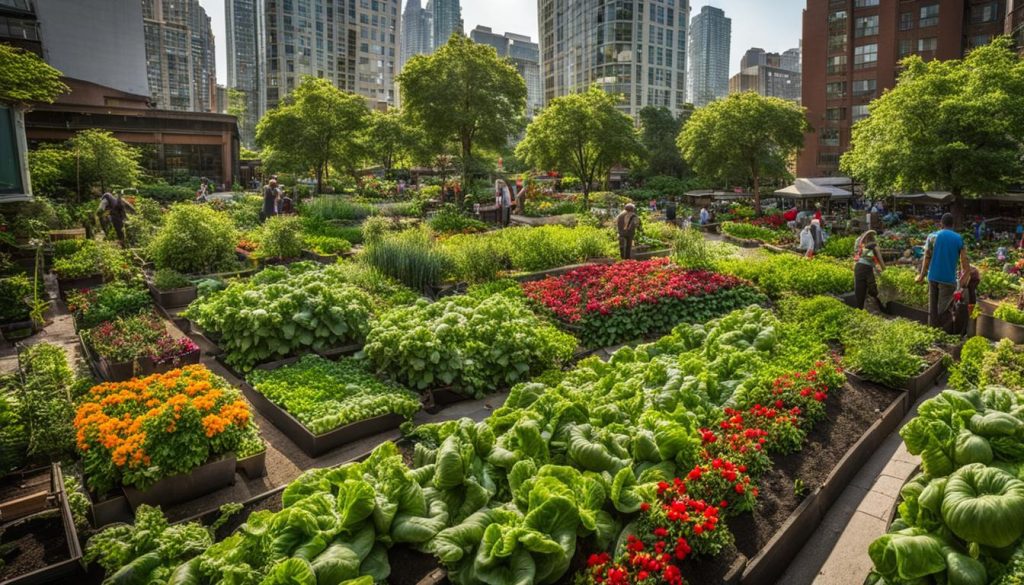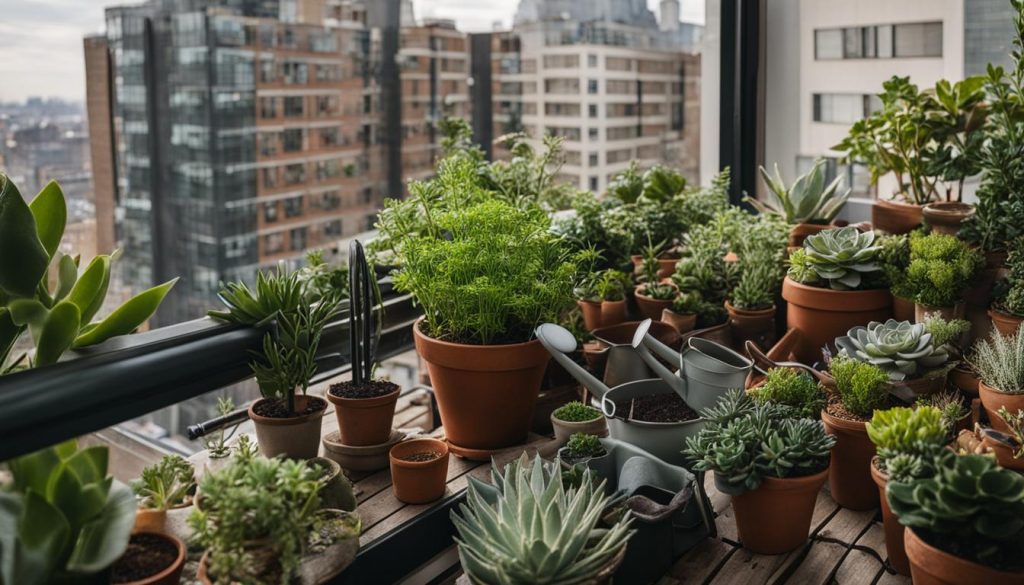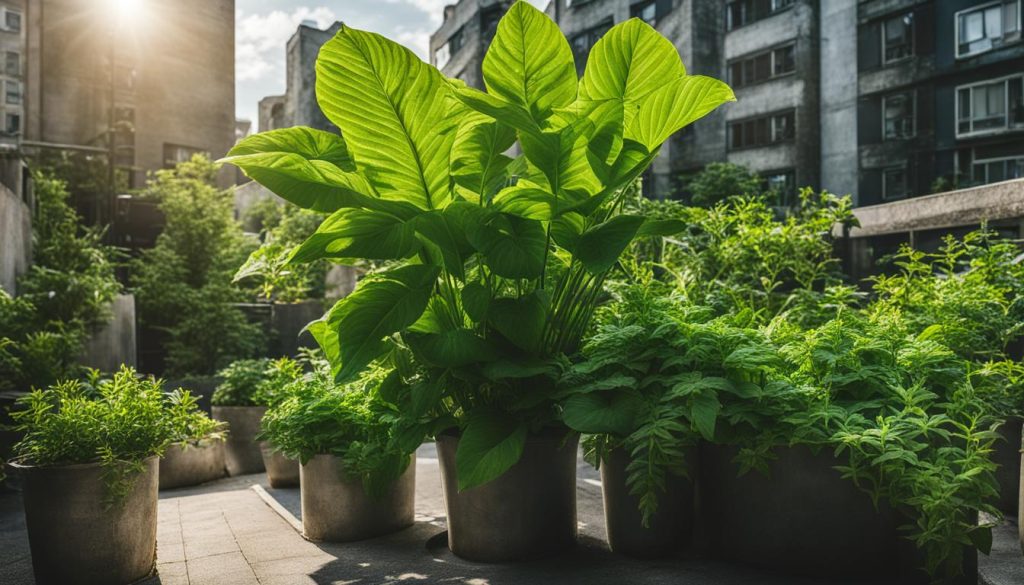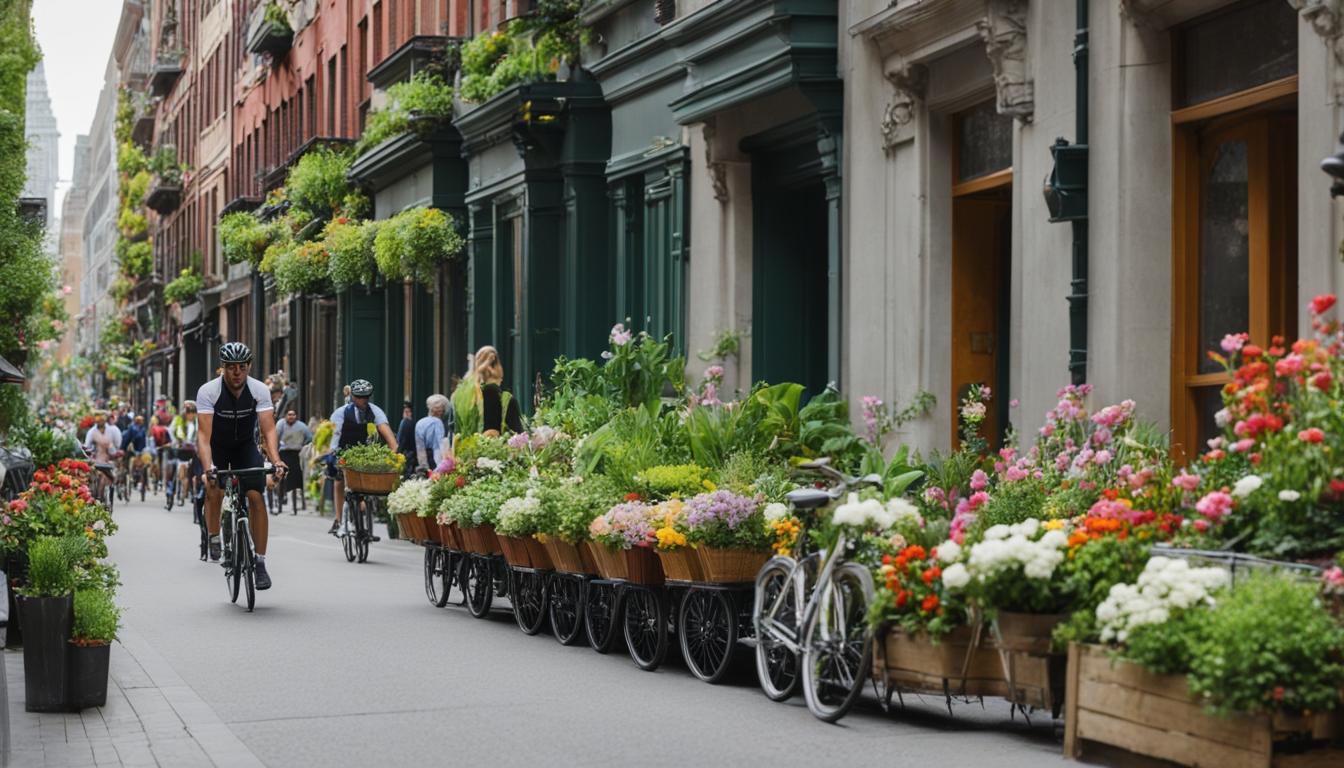Urban gardening has seen a surge in popularity as more and more city dwellers embrace the idea of bringing greenery and fresh produce into their urban spaces. In a world where concrete jungles dominate, the allure of cultivating your own garden and reconnecting with nature is hard to resist. Urban gardening allows you to grow your own food, contribute to a more sustainable future, and enjoy the numerous benefits that come with nurturing a green oasis in the heart of the city.
Whether you have a small balcony, rooftop, or backyard, urban gardening offers endless possibilities to create a thriving green space. And it’s not just about the plants – it’s about creating a sanctuary that brings solace and tranquility to your hectic urban lifestyle. So, if you’re ready to embark on this green adventure, let’s dive into the world of urban gardening and explore how you can get started.
Key Takeaways:
- Urban gardening provides an opportunity to grow your own food and enjoy the benefits of nature in an urban environment.
- It promotes sustainable living, reduces the carbon footprint, and contributes to improved air quality.
- Starting an urban garden requires careful consideration of the location, garden type, soil preparation, and plant selection.
- Popular choices for urban gardens include herbs, vegetables, and flowers that suit the climate and space available.
- Maintaining an urban garden involves regular watering, providing adequate sunlight, adding nutrients, pruning, and addressing pests.
The Benefits of Urban Gardening
Urban gardening offers a multitude of benefits that contribute to sustainable living, promote health and well-being, and foster a sense of community. By embracing urban gardening, individuals can enjoy the rewards of growing their own organic produce, while also making a positive impact on the environment and reaping valuable social connections.
Promoting Sustainable Living
One of the key advantages of urban gardening is its contribution to sustainable living. By cultivating plants within city spaces, we can reduce our carbon footprint and mitigate the impacts of food transportation. Growing food locally helps to minimize the use of fossil fuels and harmful emissions associated with long-distance food transportation. Additionally, urban gardens help improve air quality by absorbing carbon dioxide and releasing oxygen, creating healthier and greener urban environments.
Health Benefits
Urban gardening also brings significant health benefits. Growing your own food allows you to have control over the cultivation process, ensuring that you consume fresh and nutritious produce free from harmful pesticides and chemicals. It encourages a diet rich in fruits and vegetables, promoting a healthy and balanced lifestyle. Engaging in physical activities such as planting, watering, and harvesting also provides a form of exercise, contributing to overall fitness and well-being.
Fostering Community and Teaching Sustainable Practices
Urban gardening has the power to bring people together and build a sense of community. By creating communal gardens or participating in urban gardening initiatives, individuals can connect with like-minded individuals, share knowledge and resources, and foster social bonds. Moreover, urban gardens serve as educational platforms, teaching sustainable practices, and inspiring others to adopt greener lifestyles. From organizing workshops to sharing gardening tips, urban gardeners can actively contribute to the collective understanding of sustainable agriculture and foster a more environmentally conscious community.
“Urban gardening offers individuals the opportunity to reconnect with nature, promote sustainable living, and harvest the health benefits of fresh, homegrown produce.”
Overall, urban gardening presents a compelling solution for those seeking to live more sustainably in urban environments. By embracing this practice, individuals can enjoy the benefits of cultivating their own food, promoting a healthier lifestyle, and fostering a sense of community. Urban gardening is more than just a hobby; it’s a way to make a positive impact on the environment and create a thriving and sustainable urban oasis.

| Benefits of Urban Gardening | Sustainable Living | Health Benefits | Community Engagement |
|---|---|---|---|
| Reduces carbon footprint | Provides fresh and nutritious produce | Builds social connections | |
| Improves air quality | Promotes physical exercise | Shares knowledge and resources | |
| Minimizes food transportation impacts | Creates a sense of well-being | Teaches sustainable practices |
Tips for Starting Your Urban Garden
When it comes to starting your urban garden, there are a few key considerations to keep in mind. From choosing the right location to selecting the right plants, each step plays an important role in ensuring a successful and thriving garden.
Choosing the Right Location
The first step in starting your urban garden is selecting the right location. Look for an area that receives adequate sunlight and has easy access to water. This will ensure that your plants have the optimal conditions for growth.
Consider the space available to you. If you have limited space, you may want to opt for a container garden, which allows you to grow plants in pots or other portable containers. On the other hand, if you have more space available, a raised bed garden may be a suitable option.
Remember, different plants have specific sunlight requirements, so it’s important to choose a location that caters to their needs. Some plants thrive in full sunlight, while others prefer partial shade. Take this into consideration when selecting your garden location.
Garden Type
Once you’ve chosen the right location, it’s time to decide on the type of garden you want. Container gardens are versatile and can be placed on balconies, patios, or even window sills. They allow you to grow a variety of plants, even in small spaces.
On the other hand, raised bed gardens provide a dedicated space for planting and can be customized to fit your specific needs. They offer good drainage and can help prevent soil erosion.
Soil Preparation
Proper soil preparation is essential for the success of your urban garden. Start by clearing the area of any debris or weeds. Then, enrich the soil with organic matter such as compost or aged manure.
If you’re using a raised bed, fill it with a mixture of topsoil, compost, and other organic matter. This will provide your plants with the necessary nutrients for healthy growth.
Choosing Plants
Choosing the right plants for your urban garden is crucial. Consider the climate of your area and the amount of sunlight your garden receives. This will help you select plants that are well-suited to your specific conditions.
Herbs such as basil, parsley, and rosemary are great options for urban gardens. They are compact and can be grown in containers. Vegetables like tomatoes, lettuce, and peppers are also popular choices for small-space gardens. And don’t forget about adding some color with flowers like marigolds and pansies.
| Plant Type | Sunlight Requirements | Space Required |
|---|---|---|
| Herbs | Partial to full sunlight | Compact, can be grown in containers |
| Vegetables | Full sunlight | Varies depending on the plant |
| Flowers | Partial to full sunlight | Varies depending on the plant |
Remember to consider the size of your plants when choosing them for your urban garden. Some plants can grow quite large and may not be suitable for confined spaces.
By following these tips, you’ll be well on your way to starting your own thriving urban garden. Happy gardening!

Best Plants for Urban Gardens
Urban gardens are a wonderful way to bring nature into the city and enjoy the benefits of fresh produce and vibrant flowers. When planning your urban garden, it’s important to choose plants that are well-suited for the unique conditions of an urban environment. Here are some of the best plants for urban gardens:
Herbs:
- Basil: A versatile herb that thrives in containers, basil adds a burst of flavor to your dishes and is easy to grow.
- Thyme: Perfect for small spaces, thyme is a low-maintenance herb that adds a savory touch to many recipes.
Vegetables:
- Tomatoes: A classic choice for urban gardens, tomatoes can be grown in containers or hanging baskets and offer a bountiful harvest.
- Lettuce: With its compact growth habit, lettuce is ideal for small spaces and can be grown in containers or vertical gardens.
Flowers:
- Marigolds: These cheerful flowers add a pop of color to any garden and help deter pests.
- Pansies: Known for their vibrant colors, pansies are excellent choices for adding a touch of beauty to your urban garden.
When choosing plants for your urban garden, consider the specific requirements of each plant, such as sunlight and water needs. Take advantage of vertical space by using trellises or hanging baskets, and consider using raised beds or containers for easy maintenance. By selecting the best plants for your urban garden, you can create a green oasis in the heart of the city.

Creating a vibrant urban garden requires careful planning and consideration. By selecting the right plants, such as herbs, vegetables, and flowers, you can cultivate a thriving oasis in your city space. Whether you have a small balcony or a rooftop garden, these plants are well-suited for urban environments. Remember to provide them with the necessary sunlight, water, and care they need to flourish. Start your urban gardening journey and reap the many rewards it has to offer.
Maintenance Tips for Urban Gardens
As an urban gardener, it’s essential to prioritize the maintenance of your garden to ensure healthy plant growth and maximize your harvest. Here are some key maintenance tips to keep in mind:
1. Watering
Proper watering is crucial for the success of your urban garden. Ensure that your plants receive adequate moisture without overwatering. The amount of water needed may vary depending on factors such as plant species, weather conditions, and soil type. Regularly check the soil moisture and adjust your watering schedule accordingly.
2. Sunlight
Sunlight is essential for the growth of your plants. Most vegetables and herbs require at least six hours of direct sunlight daily. Observe the patterns of sunlight in your garden and position your plants accordingly. If your garden has limited sunlight, consider growing shade-tolerant plants or using artificial grow lights.
3. Nutrients
Urban gardens often require regular soil amendments to ensure optimal nutrient levels. Use organic fertilizers or compost to replenish essential nutrients in the soil. Conduct soil tests periodically to determine any nutrient deficiencies and adjust your fertilization routine accordingly.
4. Pruning
Pruning is necessary to maintain the shape, size, and health of your plants. Regularly remove dead, damaged, or diseased plant parts to prevent the spread of pests and diseases. Pruning also promotes better air circulation and sunlight penetration, leading to improved plant growth.
5. Pests
Urban gardens are susceptible to pests and diseases, but early detection and prevention are key to minimizing damage. Regularly inspect your plants for signs of pests such as aphids, slugs, or caterpillars. Implement organic pest control methods such as handpicking, introducing beneficial insects, or using natural repellents.
| Maintenance Tips for Urban Gardens | |
|---|---|
| 1. Watering | Ensure proper soil moisture without overwatering. |
| 2. Sunlight | Position plants to receive adequate sunlight. |
| 3. Nutrients | Use organic fertilizers to replenish nutrients. |
| 4. Pruning | Regularly remove dead or damaged plant parts. |
| 5. Pests | Detect pests early and use organic pest control methods. |
By following these maintenance tips, your urban garden will thrive and provide you with a bountiful harvest. Remember to regularly monitor and adjust your gardening practices based on the specific needs of your plants and the conditions in your city environment.
Design Ideas for Urban Gardens
When it comes to designing your urban garden, creativity and practicality go hand in hand. Maximizing limited space is key, and there are various design ideas that can help you achieve a beautiful and functional urban oasis. Consider the following options:
Vertical Gardens
Vertical gardens are a great choice for small areas where floor space is limited. By utilizing vertical surfaces such as walls, fences, or trellises, you can grow a variety of plants without taking up valuable ground space. This not only adds a visually appealing element to your garden but also maximizes your growing capacity.
Container Gardens
Container gardens are perfect for urban dwellers who may not have access to a traditional garden area. With containers, you have the flexibility to move your plants around and optimize sun exposure. From colorful flower arrangements to herb gardens or even small fruit trees, the possibilities are endless.
Raised Beds
Raised beds are a popular choice for urban gardeners who want more control over soil quality. They provide better drainage and allow for easier maintenance, making them ideal for growing vegetables and herbs. Plus, raised beds can also add a touch of aesthetic appeal to your garden.
Water Features
Incorporating water features into your urban garden adds a calming and soothing element, creating a peaceful oasis amidst the city bustle. Consider installing a small fountain, a pond, or even a miniature waterfall. These features not only provide a source of relaxation but also attract wildlife and add visual interest.
Remember, these design ideas are just a starting point. Let your imagination run wild and adapt these ideas to suit your personal style and available space. With some creative thinking and careful planning, you can transform even the smallest urban space into a thriving garden.
Next, let’s explore the therapeutic benefits of urban gardening and how it can positively impact your mental well-being.
The Therapeutic Benefits of Urban Gardening
Urban gardening goes beyond just creating a green space in the city. It offers a range of therapeutic benefits that promote stress relief and improved mental well-being. By transforming your urban space into a garden oasis, you can create a sanctuary for relaxation and a deep connection with nature.
Stress relief is one of the most significant benefits of urban gardening. Engaging in gardening activities, such as planting, nurturing, and harvesting, can help reduce anxiety and tension. The soothing qualities of nature combined with the physical activity involved in gardening contribute to a sense of tranquility and calmness.
Furthermore, urban gardening can have a positive impact on mental well-being. Studies have shown that spending time in nature and engaging with plants can alleviate symptoms of depression and improve overall mood. The act of caring for plants and witnessing their growth can provide a sense of purpose and accomplishment, boosting self-esteem and emotional well-being.
Creating a garden oasis in an urban setting provides a unique opportunity to escape the hustle and bustle of city life and immerse oneself in a natural environment. The soothing sights, sounds, and aromas of the garden can evoke a sense of serenity and rejuvenation. Whether it’s a small balcony garden or a community green space, the presence of plants and greenery can create a calming and peaceful atmosphere that promotes relaxation.
FAQ
Why is urban gardening becoming popular?
Urban gardening has become popular because it allows people to bring greenery and fresh produce into city spaces, promoting sustainability and offering the benefits of nature in an urban environment.
What are the benefits of urban gardening?
Urban gardening offers the opportunity to grow healthy, organic produce, promotes sustainable living by reducing the carbon footprint and improving air quality, and fosters community and teaches sustainable practices to others.
How do I start an urban garden?
To start an urban garden, choose a location with adequate sunlight, water access, and soil quality. Decide on the type of garden you want (container or raised bed) and prepare the soil accordingly. Choose plants suitable for your climate, space, and sunlight availability.
What are the best plants for urban gardens?
Popular choices for urban gardens include herbs like basil and thyme, vegetables like tomatoes and lettuce, and flowers like marigolds and pansies. Choose plants based on your location and the amount of sunlight available.
How do I maintain an urban garden?
Maintaining an urban garden involves regular watering, ensuring plants receive enough sunlight, adding nutrients to the soil, pruning for healthy growth, and addressing pests and diseases.
What are some design ideas for urban gardens?
Design ideas for urban gardens include vertical gardens for small areas, container gardens for portability, raised beds for controlled soil quality, and water features for a relaxing atmosphere.
What are the therapeutic benefits of urban gardening?
Urban gardening provides therapeutic benefits such as stress relief, improved mental well-being, and a garden oasis in the city for relaxation and connection with nature.




